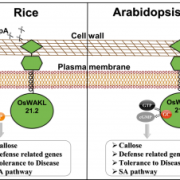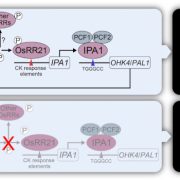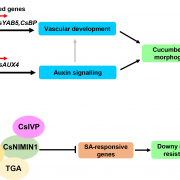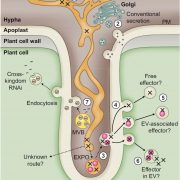Mechanism by which viruses are excluded from plant stem cells
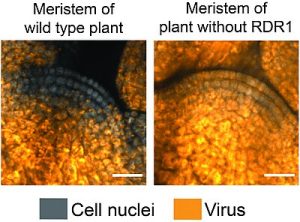 Horticulturalists have long used the technique of meristem culture to propagate plants, as meristems are generally considered to be free of viruses. However, the mechanism by which the stem cells in meristems exclude viruses has been unclear. Here, Incarbone and Bradamante et al. identified roles for RNA-dependent RNA polymerase 1 (RDR1) and salicylic acid (SA) in this mechanism. The authors inoculated leaves with Turnip mosaic virus expressing fluorescent tags, and then used imaging to see if the virus entered the stem cells. Interestingly, in wild-type plants, the virus appears in the stem cells transiently, but is then excluded, whereas in rdr1 mutant plants the virus persists in the stem cells. RDR1 is not itself expressed in stem cells, suggesting it produces a mobile signal that inoculates these cells and protects them from the virus. The authors further identified a role for salicylic acid (SA) in viral exclusion. In viral-treated plants, SA levels increase, and SA promotes the transcription of RDR1. These results suggest a model in which virus infection causes an increase in SA levels, which lead to an increase in RDR1 levels, which amplify antiviral RNAi in infected tissues, providing stem cells with RNA-based virus sequence information that prevents virus proliferation. It remains unclear why this pathway is stem-cell specific. (Summary by Mary Williams @PlantTeaching) Proc. Natl. Acad. Sci. USA 10.1073/pnas.2302069120
Horticulturalists have long used the technique of meristem culture to propagate plants, as meristems are generally considered to be free of viruses. However, the mechanism by which the stem cells in meristems exclude viruses has been unclear. Here, Incarbone and Bradamante et al. identified roles for RNA-dependent RNA polymerase 1 (RDR1) and salicylic acid (SA) in this mechanism. The authors inoculated leaves with Turnip mosaic virus expressing fluorescent tags, and then used imaging to see if the virus entered the stem cells. Interestingly, in wild-type plants, the virus appears in the stem cells transiently, but is then excluded, whereas in rdr1 mutant plants the virus persists in the stem cells. RDR1 is not itself expressed in stem cells, suggesting it produces a mobile signal that inoculates these cells and protects them from the virus. The authors further identified a role for salicylic acid (SA) in viral exclusion. In viral-treated plants, SA levels increase, and SA promotes the transcription of RDR1. These results suggest a model in which virus infection causes an increase in SA levels, which lead to an increase in RDR1 levels, which amplify antiviral RNAi in infected tissues, providing stem cells with RNA-based virus sequence information that prevents virus proliferation. It remains unclear why this pathway is stem-cell specific. (Summary by Mary Williams @PlantTeaching) Proc. Natl. Acad. Sci. USA 10.1073/pnas.2302069120


